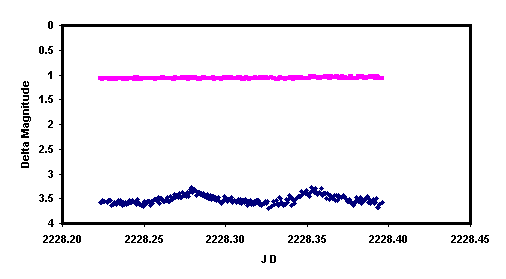 CBA
Belgium Observatory
CBA
Belgium ObservatoryDetection of superhumps in DM Dra during its November 2001 outburst
 CBA
Belgium Observatory
CBA
Belgium Observatory
Detection of superhumps in DM Dra during its November 2001 outburst
|
|
On 2001, November 14.176 UT, Timo Kinnunen
(Finland) reported a rare outburst of the large-amplitude dwarf nova DM Dra
on VSNET. The
previous outburst of DM Dra was spotted in October 2000 by Patrick Schmeer
(vsnet-alert 5338).
DM Dra was originally discovered by Stepanyan, as SVS 2426,
and spectroscopic observations revealed an O-B star, which is consistent |
| I accumulated 4.1 hours of observations (269 datapoints), resulting in the light curve at right. The observations clearly revealed the presence of genuine, single-peaked superhumps with an amplitude of 0.36 mag, and a period of 0.0734 +/- 0.0030 d (PDM technique). This value substantially differs from the one obtained by Howell et al. during quiescence (see above). The above observations firmly establish DM Dra as a new SU UMa type dwarf nova. |
 |
|
|
|
|
|